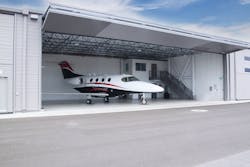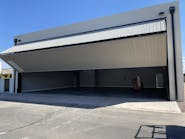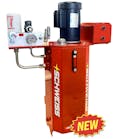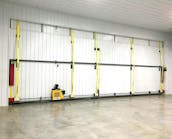2021 Airport Business Project of the Year: Scottsdale Finds Growth Solution in Tight Quarters
Scottsdale Airport (SCF) is a general aviation reliever airport located in the heart of Scottsdale, Ariz. Due to its location, ease of access and competitive amenities, the airport is an ideal choice for business and leisure travelers which presents an issue of finding additional hangar space.
The airport recorded 195,852 takeoffs and landings in 2020. It has around 460 based aircraft at the airport and within the surrounding airpark area. The continued projected growth meant the airport has to accommodate more tenants, so they opted to build 14 new box hangars.
Sarah Ferrara, aviation planning and outreach coordinator for Scottsdale Airport said stakeholders from across the airport discussed a solution. They decided to install the buildings on the current site for the North General Aviation Box Hangars.
“Basically, we just didn’t have a whole lot of airport property available,” she said. “It came down to the point that we don’t have a lot of different areas to put this.”
The development plan looked to build 14 box hangars in two phases. The construction of seven contiguous box hangars, each dimensioned at 62 feet wide by 47 feet deep began in fall 2019 and was completed in December. The other seven hangars are currently under construction with an anticipated completion in October.
The airport is well developed and is virtually landlocked. Airport officials expect more growth, more operations and more economic opportunity spurred from the airport. This necessitates the need for airport and city officials to be creative and find ways to accommodate additional aircraft.
Michael Braun, vice president, of DWL Architects + Planners Inc., said the firm was tasked with bringing in a simple, efficient and cost-effective design for the new hangars so the airport could price out and find tenants.
The hangars are located on the northwest side of the airport, which was previously an underutilized tiedown space. It was the only viable space for the project although there were challenges with fitting the structures in, Braun said. It’s right up against the property line, against the taxiway and against the building restriction line.
“You want to respect the property lines, the FAA regulations for safety and also, we’re building an asset for the aviation community,” Braun said. “We want to make sure we’re getting the most aircraft and the biggest aircraft we can in that space when a foot or six inches makes a difference, yet you want to provide some tolerance for construction. That was the real challenge.”
The notion of the box hangars evolved from the airport’s Master Plan completed in 2015. The plan identified the need to accommodate smaller general aviation aircraft. Various options were studied, and the palpable idea was to develop individual executive box hangars on the western edge of the Kilo ramp.
A North General Aviation Hangar Development Analysis report completed in 2017 evaluated the maximum hangar size and placement, identified potential aircraft that could use the hangars and estimated the hangar development costs. A further financial lease analysis of the project costs and potential lease revenues resulted in a recommendation to pursue the project to maximize the efficiency of the airport and its desire to serve the overall aviation community.
With city council approval, the design of the first phase of the box hangar was completed by DWL Architects.
Sun Eagle Construction built the hangars. The contracted construction costs are around $8 million for all 14 hangars. Funding for the project comes from aviation enterprise funds.
The hangars feature direct runway access, electric bi-fold doors, roof insulation, LED lighting, fire sprinkler systems, office space and fuel discounts. Tenants are also able to wash their aircraft inside the hangar with an oil/water separator.
Braun said the design is both energy efficient and durable. Utilizing a dual panel system allows better thermal resistance than a standard skin. They also used masonry for the north and west walls, which helps compared to a premanufactured metal structure.
“You have a masonry wall adjoining the adjacent property between certain hangars and it creates a more durable product,” Braun said. “Durability, responsive to the environment and a little more flexibility because you can hang certain things off masonry that can’t do on a metal building."
All 14 of the hangers were designed to about 3,000 square feet each. Five of the first seven built include restrooms and air-conditioned storage areas. The second seven don’t have those features, but the plumbing and structure is there if they want to add them in the future.
“Early on there was a lot of inter-client involvement mostly through the airport where some wanted this feature and some didn’t,” Braun said. “They didn’t want to build it for someone who didn’t want it and have a higher lease rate, so they were being responsive to those needs.”
The hangars were marketed and brokered by DMD Real Estate Services for three to five-year terms. The monthly base rent will generate revenue to the airport enterprise fund and offset the airport’s investment in building the hangars.
The airport was able to lease all 14 hangars and achieve the goal of providing additional and lucrative hangar space for general aviation users.
Some tenants were concerned general aviation traffic would be squeezed out of Scottsdale in favor of more corporate traffic. Ferrara said the box hangars provide nice spaces for general aviation traffic to ensure they’re still able to operate at the airport.
“Some of the amenities were that if we place them on the Kilo ramp, they have direct runway access,” she said. “They were also able to work out a deal with a fuel discount for the folks that were going into the box hangars along with relatively short three to five year leases.”




